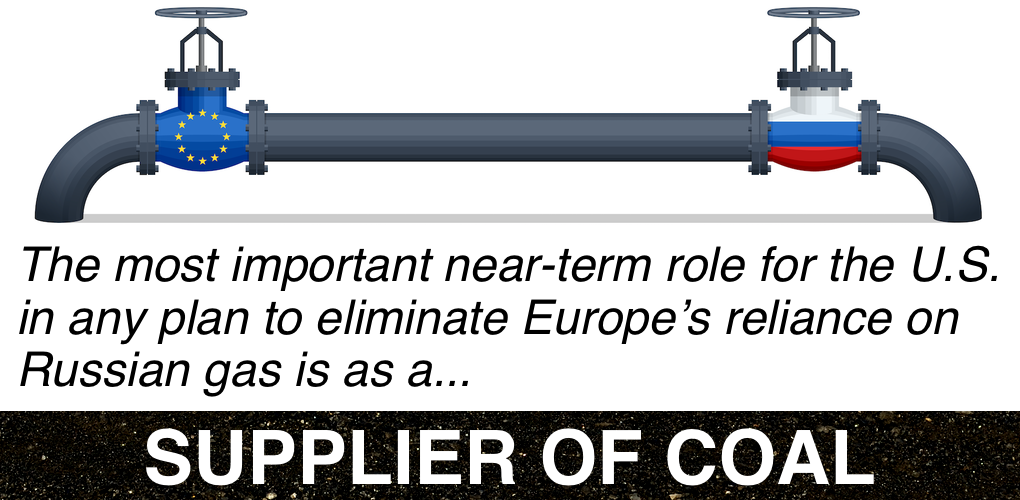
European Energy Independence with U.S. Coal
This week, Fatih Birol, the head of the International Energy Agency, warned that the global energy crisis is likely to get worse before it gets better, adding the coming winter for Europe, “will be very, very difficult.”
His remarks reflect the increasing likelihood that Russia will completely cut off the flow of its natural gas to Europe. Even though European buyers have pivoted to alternative gas supplies, particularly LNG, a Russian embargo would necessitate gas rationing or worse without an aggressive, multi-pronged plan to radically reduce gas use.
While the European Commission rolled out a plan to curtail European reliance on Russian gas in May, that plan – REPowerEU – already appears in need of significant strengthening and augmentation. The good news, however, is that energy experts on both sides of the Atlantic think it’s possible for Europe to gain independence from Russian gas by this coming winter. While there’s no silver bullet to make it happen, coal – particularly American coal – will be needed to do much of the heavy lifting.
“The Most Important Near-term Role”
A new report from experts at the ZERO Lab at Princeton University identifies several paths for European countries to break their Russian gas habit by the close of this October. All three approaches lean on ramping up the near-term use of coal – at varying levels – to slash gas use.
Getting Europe the coal it will need will not be easy. Coal markets are already tight due to supply chain problems, industry contraction following the implosion of demand during the pandemic, and reduced and reshuffled supply due to sanctions on Russian coal exports that had accounted for half of Europe’s hard coal supply. The report projects that Europe will need an increase of 30-55 MT of hard coal from the global market during the period from April 2022 to March 2023. This amount is equivalent to 3-6% of the global thermal coal trade. Securing this supply for Europe, write the authors, “will likely depend on concerted action by the United States and other European allies.”
In fact, while so much attention has been given to what the U.S. can do help provide gas to Europe, the authors found that, “the most important near-term role for the United States in any plan to eliminate Europe’s reliance on Russia gas is as a supplier of coal.”
Along with securing U.S. supply for export, the authors also recognize the need for government action to address existing and potential logistics challenges. They write, “although more than enough rail and port terminal capacity exists on the U.S. Atlantic and Gulf coasts to handle the required quantities of coal, a rapid ramp-up in exports could face issues with congestion and labor shortages. Alleviating these potential bottlenecks to additional coal exports should be a priority of any U.S. government action in support of European energy independence.”
They conclude, “with concerted and strategic effort, we estimate that the United States could increase near-term exports to Europe by on the order of 30-55 MT/yr. This would be sufficient to meet the deficit in global coal trade, play a pivotal role in underwriting Europe’s energy security, and enable the elimination of Russian gas imports.”
The National Mining Association endorsed just such an effort this March when the White House first announced a ban on Russian energy imports. Rich Nolan, NMA president and CEO, said, “as the nation with the world’s largest coal reserves, the U.S. can – and should – play a critical role in helping meet Europe’s energy and steelmaking needs in the months and years ahead. Private industry and policymakers should work hand-in-hand to ramp up domestic production and tackle supply chain barriers that stand in the way, including challenges with our nation’s railways and ports.”
American voters are also strongly behind such an effort. In a national poll from June, nearly 6 in 10 voters agreed the U.S. should ramp up domestic coal production to help our European allies wean themselves off of Russian energy, with just 2 in 10 voters disagreeing and the remainder having no opinion.
The Pivot is Beginning but Needs a Boost
A reembrace of coal is happening across Europe and not a moment too soon. Germany, for example, is not only ramping up use of operating coal capacity but has passed legislation bringing 10 GW of mothballed capacity back into service. The Federation of German Industries– long weary of Germany’s race away from baseload power — called the decision “better late than never.”
U.S. thermal coal exports to Europe are up 115% through May and were 142% higher this May compared to last. U.S. producers are responding to European buyers. How much more U.S. coal can make its way to Europe is a critically important question but policy assistance in Europe and the U.S. could play a decisive role in ensuring it gets where it’s needed.
It has taken a crisis, but Europe is finally recognizing that a successful transition to a renewable energy future can’t happen without energy security. Europe’s coal fleet – the energy infrastructure it should have been leaning on for the transition all along – is precisely the bridge needed to navigate this unprecedented moment.
The U.S., for its part, needs to come to the assistance of our allies and ensure we’re taking every step possible to defang Russia’s energy weapon. As the Europeans are recognizing, and as the experts at Princeton argue, the key role the U.S. can play is as a supplier of coal. It’s now time for Congress and the Biden administration to step up to the plate.
- On July 13, 2022
